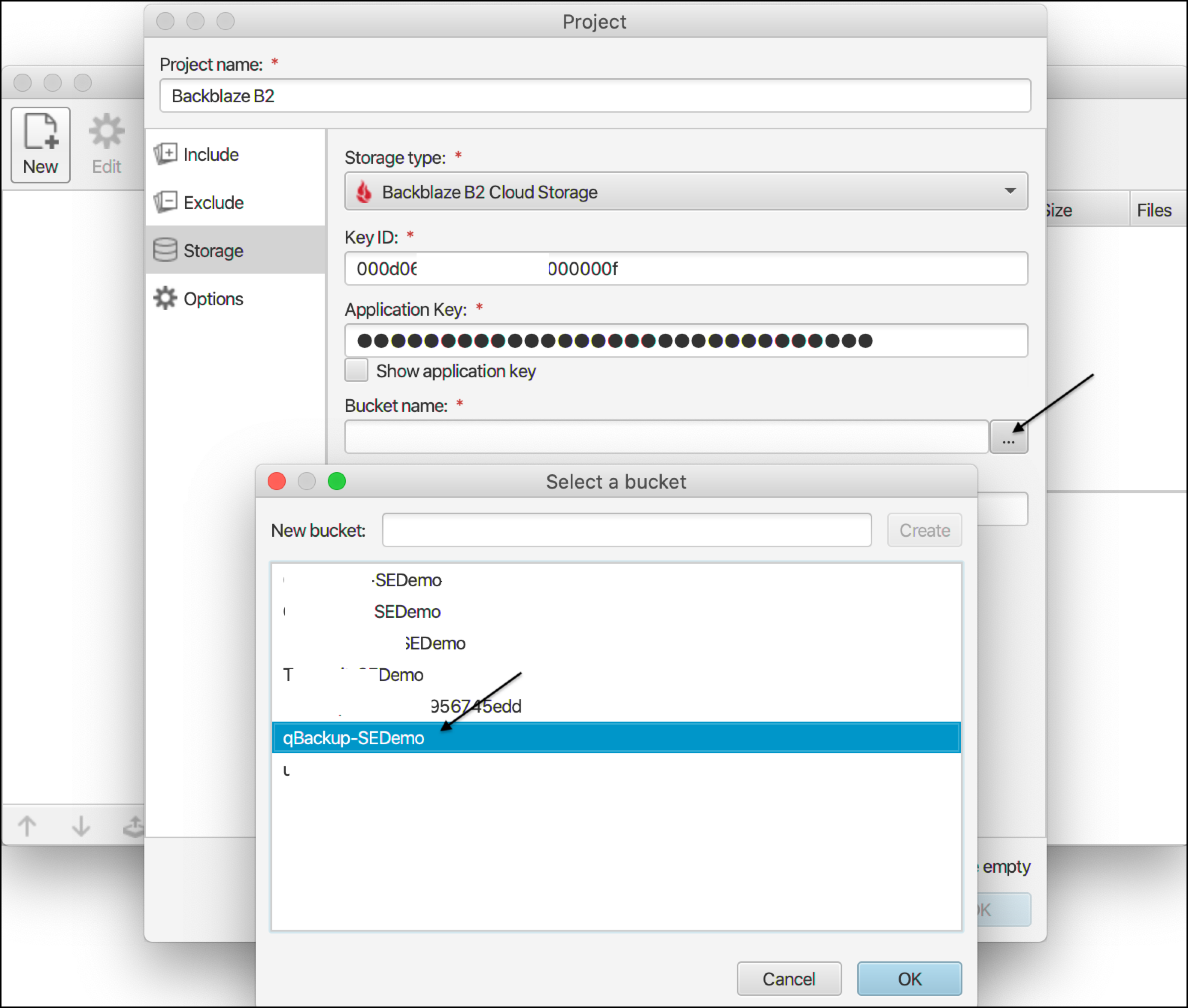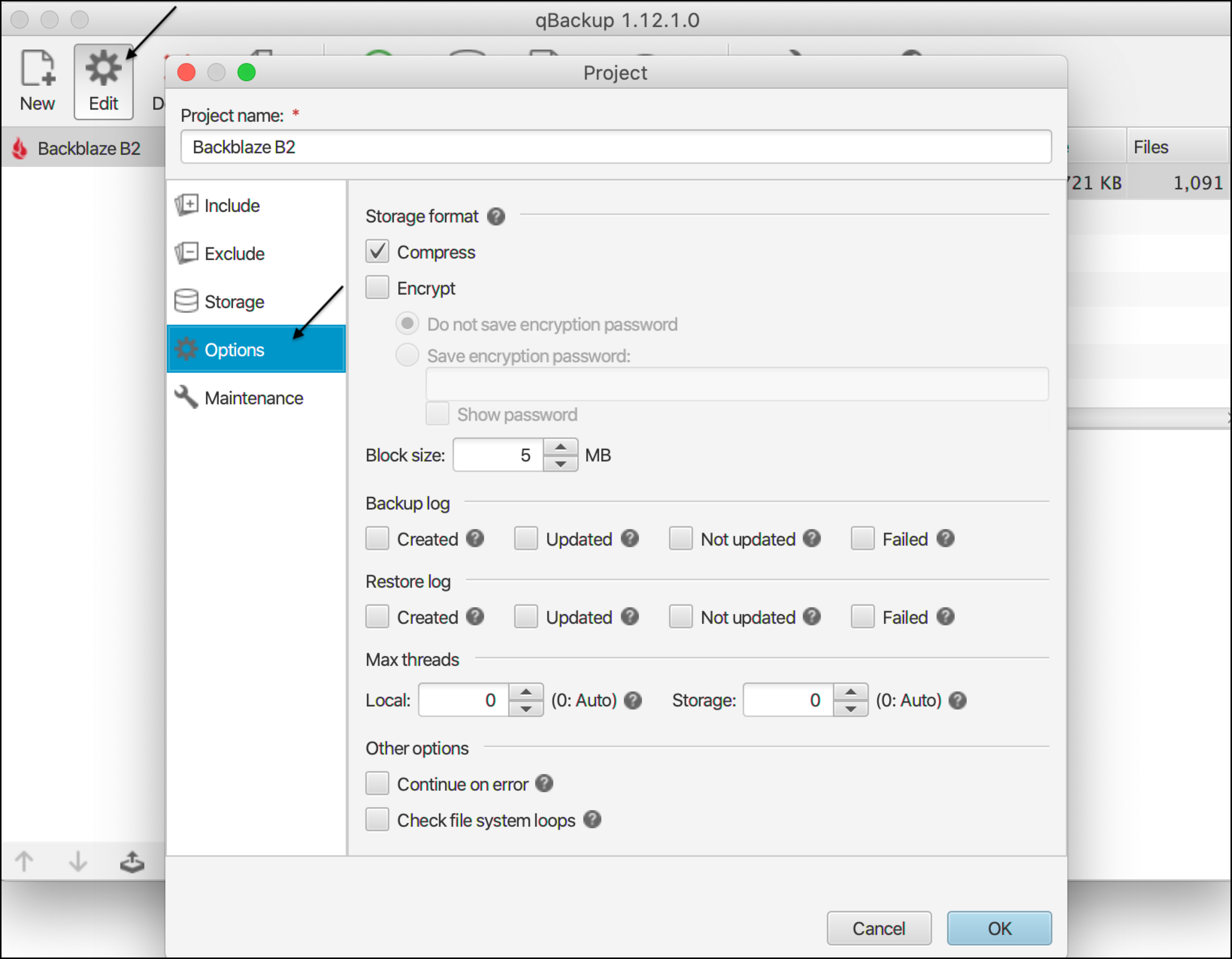qBackup Integration with Backblaze B2
- Print
- DarkLight
qBackup Integration with Backblaze B2
- Print
- DarkLight
Article summary
Did you find this summary helpful?
Thank you for your feedback
qBackup is a backup application that is compatible with Mac, Windows, and Linux. You can use qBackup and Backblaze B2 Cloud Storage to set up projects that allow you to securely run backups of your data offsite.
Enable Backblaze B2
Before you begin: You must have a Backblaze B2 Cloud Storage account. If you already have a Backblaze account and the left navigation menu contains a B2 Cloud Storage section, your account is already enabled for Backblaze B2.
- Sign in to the Backblaze web console.
- In the user menu in the upper-right corner of the page, select My Settings.
- Under Enabled Products, select the checkbox to enable B2 Cloud Storage.
- Review the Terms and Conditions, and click OK to accept them.
Create a Bucket
- Sign in to the Backblaze web console.
- In the left navigation menu under B2 Cloud Storage, click Buckets.
- Click Create a Bucket.
- Enter a name for your bucket. Bucket names must be at least six characters and globally unique.
A message is displayed if your bucket name is already in use. - Select a privacy setting: Private or Public.NoteYou can change a bucket's privacy settings at any time.
Files that are in a private bucket require authentication to perform an action, for example, downloading.
Public buckets do not require authentication so you can easily access files. If this is your first time creating a public bucket, complete the following tasks to ensure that you have the correct permissions to create a public bucket:
1. Verify your email address.
2. Have a payment history on file, or use the credit card form to pay a small fee that is credited to your account balance. - If applicable, enable a Backblaze B2 server-side encryption key.
- Enable Object Lock to restrict a file from being modified or deleted for a specified period of time.
- Click Create a Bucket, and copy the value that is in the Endpoint field; you may need this value later.
- Click Lifecycle Settings to control how long to keep the files in your new bucket.
Create an Application Key
- Sign in to the Backblaze web console.
- In the left navigation menu under B2 Cloud Storage, click Application Keys.
- Click Add a New Application Key, and enter an app key name.
You cannot search an app key by this name; therefore, app key names are not required to be globally unique. Key names are limited to 100 characters and can contain letters, numbers, and "-", but not I18N characters, such as é, à, and ü. - Select All or select a specific bucket in the Allow Access to Bucket(s) menu.
- Optionally, select your access type (Read and Write, Read Only, or Write Only).
- Optionally, select Allow List All Bucket Names.
This option is required for the B2 Native API b2_list_buckets and the S3-Compatible API S3 List Buckets operations. - Optionally, enter a file name prefix to restrict application key access only to files with that prefix.
Depending on what you selected in step #4, this limits application key access to files with the specified prefix for all buckets or just the selected bucket. - Optionally, enter a positive integer to limit the time, in seconds, before the application key expires.
The value must be less than 1000 days (in seconds). - Click Create New Key, and note the resulting keyID and applicationKey values.
Note
When you create a new app key, the response contains the actual key string, for example N2Zug0evLcHDlh_L0Z0AJhiGGdY. You can always find the keyID on this page, but for security, the applicationKey appears only once. Make sure you copy and securely save this value elsewhere.
Connect a Bucket in qBackup
Before you begin: You must download and install the qBackup client for your operating system here.

- Launch the qBackup client.
An empty client is displayed that is ready for you to set up. - In the upper-left menu, click New and enter a name for your project.
- In the Include menu, click Files, Folders, or Directories to add them to the project.
- In the Exclude menu, select the files or folders within the directories that you selected that you do not want to be included in the project.
- In the Storage menu, select Backblaze B2 Cloud Storage from the Storage Type field.
- Enter your Backblaze B2 Key ID and Application Key.
All of the buckets that this app key is connected to are displayed. - Select the Backblaze B2 bucket that you want to contain the project's backup, and click OK.
- Click OK.
Run a Backup

- Select your new project in the left menu.
- Click Backup in the top menu.
Optimize a Backup Process
You can enable additional settings to improve your performance.
Note
The settings that you can adjust for performance depend on the power of your CPU and the amount of RAM that your machine has available.
Many of these settings can cause backups to fail prematurely if not set properly. Therefore, finding the optimal settings for your system may take experimentation. qBackup's backups will fail if you run out of memory.
Many of these settings can cause backups to fail prematurely if not set properly. Therefore, finding the optimal settings for your system may take experimentation. qBackup's backups will fail if you run out of memory.

- Select your project from the left menu, and view the current write speed.
You can find your estimated upload speed here. - Click Edit in the top menu, and select Options.
- Adjust the following settings as desired:
- Compress: This setting allows the upload to minimize the amount of data that is sent. Backblaze recommends that you enable the Compress setting.
- Encryption: This setting allows you to enter a password to encrypt your data for an extra layer of security. There is no way to recover your data if your password is lost. Backblaze recommends that you store your password in a secure location.
- Block Size: This setting controls the size of the chunks that the backup is split into. Increasing block size can help upload speeds for large files. When you set this to a large value, keep in mind that the backup job loads this data into system memory (RAM). Keep your memory availability in mind as the backup fails if qBackup runs out of it.
- Max Threads: This setting controls how many threads qBackup is allowed to use to write to your Backblaze B2 account. Leaving these values at 0 allows the application to approximate automatically for you which settings will best work.
Localindicates how many threads will run writes to local storage during a restore job.Storageindicates how many threads will run writes to your remote Backblaze B2 Cloud Storage during a backup job.
Backblaze recommends not increasing threads by more than five increments at a time to avoid slowdowns or system crashes.
Was this article helpful?
